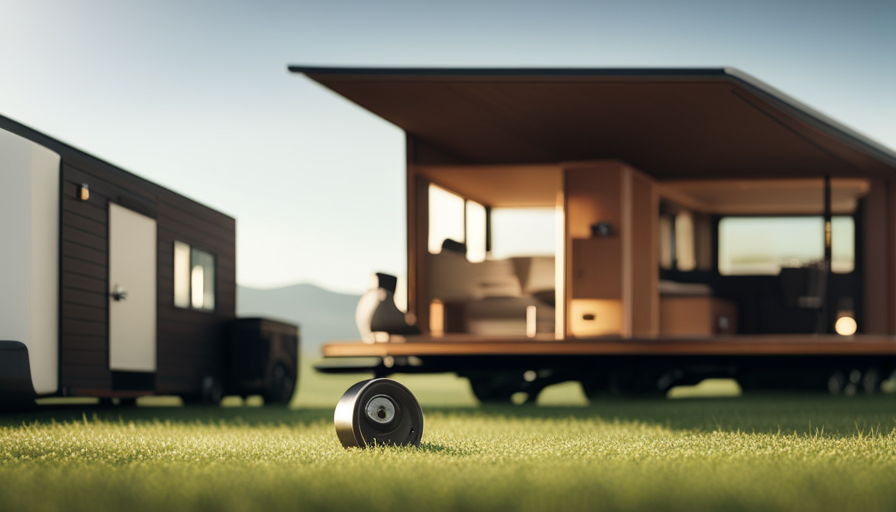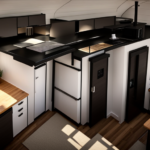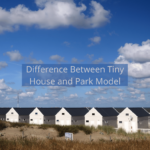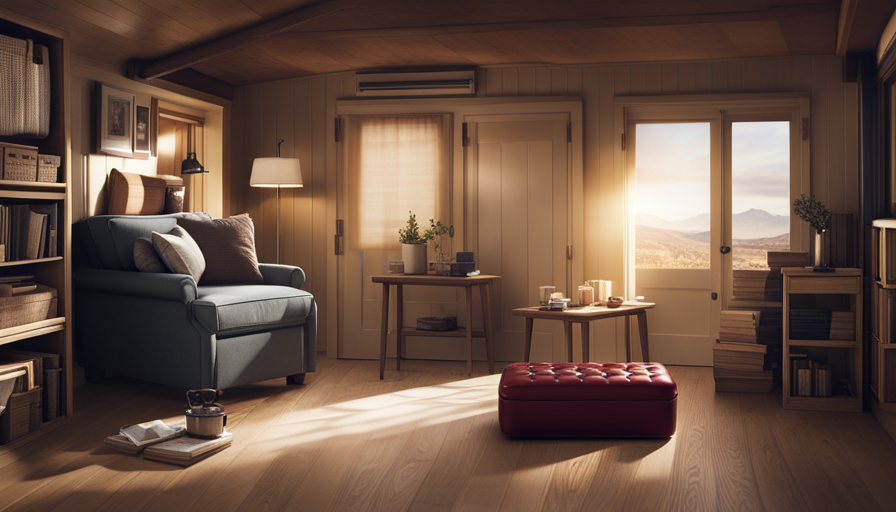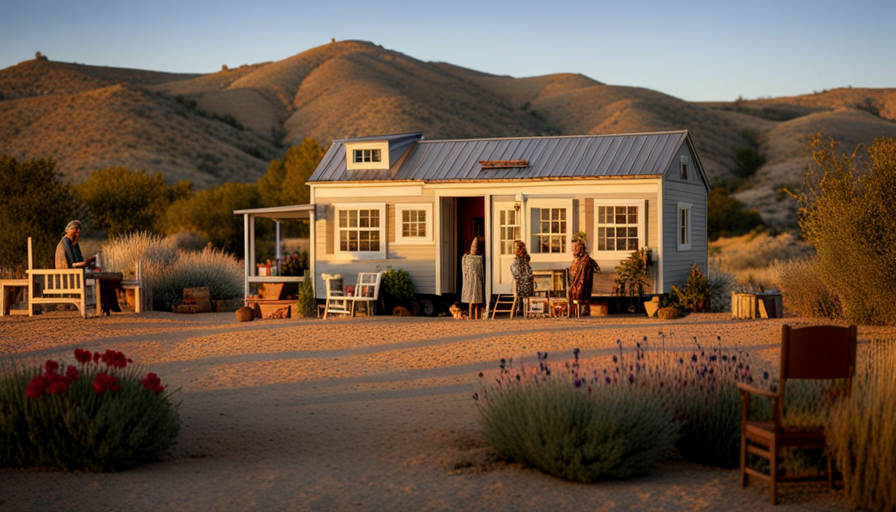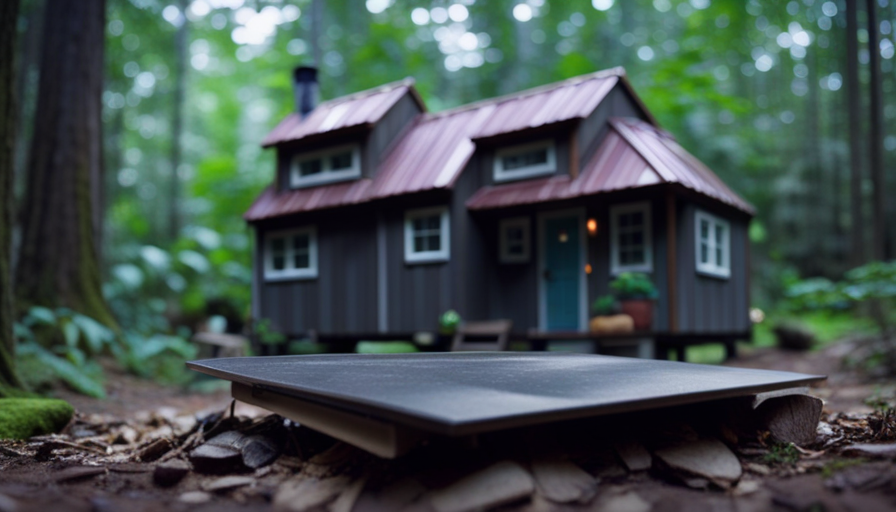Within the sphere of unconventional living spaces, tiny houses and trailers frequently come up in discussion together. Yet, despite what appears to be their similar exteriors, there are unique distinctions between these two types of residences that differentiate them.
Like two sides of a coin, the tiny house and the trailer may share some commonalities, but they each offer a unique experience and lifestyle. While a trailer may appear to be a miniature home on wheels, a tiny house is a carefully crafted, compact living space designed to maximize efficiency and functionality.
From size and structure to mobility and design, there are various factors that differentiate these two housing options.
In this article, we will delve into the nuances that distinguish a tiny house from a trailer, exploring everything from legal considerations to environmental impact, and ultimately helping you make an informed decision about which option suits your needs and aspirations.
Key Takeaways
- Tiny houses are carefully crafted, compact living spaces designed for efficiency and functionality, while trailers have a more standardized design.
- Tiny houses can be customized in size and structure, unlike trailers which have fixed dimensions.
- Tiny houses are typically built with higher quality materials, providing better insulation and durability.
- Tiny houses offer the ability to tow or move them to different locations, while trailers are specifically built to be towed.
Size and Structure
If you’re looking for a cozy and compact living space, a tiny house offers you the advantage of customizing its size and structure to fit your specific needs, making it distinctly different from a trailer.
Tiny house construction allows for endless possibilities when it comes to designing the layout and floor plan. Unlike trailers, which often have fixed dimensions and limited options for customization, tiny houses can be built from scratch with your desired dimensions in mind. This means you can create a space that is perfectly tailored to your lifestyle, whether that means adding extra storage, a lofted sleeping area, or a fully functional kitchen.
Another key difference between tiny houses and trailers is the materials used in their construction. Tiny houses are typically built with higher quality materials, such as solid wood or steel framing, which provide better insulation and durability. Trailers, on the other hand, often use lightweight materials that may not withstand harsh weather conditions as well. This difference in construction materials not only affects the overall strength and longevity of the structure but also contributes to a more comfortable and energy-efficient living environment.
The size and structure of a tiny house are distinct from those of a trailer due to the customizable nature of tiny house construction and the use of higher quality materials.
Now, let’s explore the mobility and portability of tiny houses.
Mobility and Portability
When it comes to mobility and portability, tiny houses offer the ability to tow or move them to different locations. This feature allows homeowners to have the freedom and flexibility to change their living environment whenever they desire.
However, it’s important to consider transport regulations and restrictions, as certain areas may have limitations on the size and weight of the tiny house that can be transported on public roads. It’s crucial to understand these regulations to ensure a smooth and legal transportation process.
Ability to tow or move
Although tiny houses and trailers may seem similar, one key difference lies in their ability to be easily towed or moved. Tiny houses are typically built on a permanent foundation and are not designed to be towed frequently. On the other hand, trailers are specifically built to be towed and are equipped with features such as hitches, axles, and wheels for easy transportation.
The ability to tow or move a trailer is determined by its size and weight limitations, as well as the towing capacity of the vehicle used. In contrast, tiny houses are subject to parking constraints, as they require a designated space with proper zoning regulations.
To further illustrate the differences, consider the following table:
| Aspect | Tiny House | Trailer |
|---|---|---|
| Mobility | Limited mobility due to permanent foundation | Designed for easy towing |
| Parking | Requires designated space with zoning | Can be parked in various locations |
| Towing Capacity | Not applicable | Determined by size and weight limits |
Understanding these differences is crucial when considering the transport regulations and restrictions involved in moving tiny houses.
Transport regulations and restrictions
To fully understand the regulations and restrictions surrounding transportation, you need to consider the specific requirements and limitations for moving your compact dwelling.
Transport regulations for tiny houses depend on various factors, including size, weight, and the type of vehicle used for towing. Size restrictions are an important consideration, as they determine whether your tiny house can be legally transported on public roads.
Different jurisdictions have different rules regarding the maximum width, height, and length of a structure that can be moved without a special permit. It is essential to research and comply with these regulations to avoid legal issues and ensure a safe and hassle-free journey.
Understanding the transport regulations will help you plan the functionality and design of your tiny house accordingly, ensuring it meets all the necessary requirements.
Functionality and Design
If you’re looking for a compact living space, have you considered how a tiny house differs from a trailer in terms of functionality and design? While both options offer a smaller footprint, there are distinct differences in safety features and storage solutions. Let’s take a closer look at these aspects in the table below:
| Functionality | Tiny House | Trailer |
|---|---|---|
| Safety Features | Tiny houses often incorporate safety features like fire extinguishers, smoke detectors, and carbon monoxide detectors. They may also have built-in escape routes in case of emergencies. | Trailers typically have basic safety features like seatbelts and airbags, but they may lack the same level of fire safety measures found in tiny houses. |
| Storage Solutions | Tiny houses are designed with smart storage solutions in mind. They often feature built-in cabinets, shelves, and innovative space-saving furniture. | Trailers typically have limited storage options, with most relying on basic closets and cabinets. |
Considering these differences in functionality and design, it’s important to also consider legal and zoning considerations when deciding between a tiny house and a trailer. [Transition sentence to the next section: Legal and zoning considerations are crucial factors to keep in mind when making this decision.]
Legal and Zoning Considerations
When considering a compact living space, have you thought about the legal and zoning considerations that come with choosing between a tiny house and a trailer? It’s important to understand the legal implications and zoning restrictions before investing in a tiny house or a trailer.
Here are three key factors to consider:
-
Legal considerations: Before purchasing a tiny house or a trailer, it’s crucial to research the local laws and regulations regarding these types of dwellings. Some areas may have specific regulations for tiny houses, such as size limitations, building codes, and permits required. Understanding these legal considerations will help you navigate the process smoothly and avoid any potential legal issues.
-
Zoning restrictions: Zoning regulations vary from one location to another, and they can dictate where you can park or place your tiny house or trailer. Certain areas may have restrictions on living in a tiny house on wheels, while others may have designated zones or communities for these types of dwellings. It’s essential to check the zoning restrictions in your desired location to ensure compliance and avoid any conflicts.
-
Homeowners’ associations (HOAs): If you plan to live in a community governed by an HOA, it’s crucial to review their rules and regulations. Some HOAs may have restrictions on tiny houses or trailers, so it’s important to understand their policies before making a decision.
Considering these legal and zoning considerations will help you make an informed choice between a tiny house and a trailer.
In the next section, we will explore the cost and affordability factors of these compact living options.
Cost and Affordability
When considering the cost and affordability of a tiny house, there are two key points to consider: the initial investment and ongoing expenses.
The initial investment for a tiny house can vary greatly depending on factors such as size, construction materials, and customization options.
Ongoing expenses include maintenance and utilities, which can also vary depending on the location and specific features of the tiny house.
It’s important to carefully consider these factors to ensure that a tiny house is a financially viable option in the long term.
Initial investment and ongoing expenses
To compare the initial investment and ongoing expenses of a tiny house and a trailer, you’ll find that a tiny house typically requires a higher upfront cost, but offers the potential for long-term savings. For example, while purchasing a pre-built tiny house can cost around $50,000, consider the case of Jane who built her own tiny house for $25,000, which allowed her to save on labor costs and customize the space to her needs.
| Category | Tiny House | Trailer |
|---|---|---|
| Initial Investment | Higher upfront cost due to construction and customization expenses. | Lower upfront cost as trailers are often less expensive to purchase. |
| Ongoing Expenses | Lower long-term costs due to energy-efficient features and smaller size. | Higher ongoing expenses for utilities and maintenance. |
Although the initial investment for a tiny house may be higher, the ability to customize and the potential for long-term savings make it an appealing option. Moving forward, let’s delve into the comparison of maintenance and utilities between tiny houses and trailers.
Comparison of maintenance and utilities
The maintenance and utility costs for a tiny house compared to a trailer can greatly impact long-term savings.
When it comes to maintenance, tiny houses require regular upkeep just like any other home. However, due to their smaller size, maintenance tasks such as painting, roof repairs, and general upkeep can be less time-consuming and more affordable. On the other hand, trailers may require more frequent maintenance due to their exposure to the elements and constant movement.
In terms of utilities, tiny houses often have more efficient systems in place, such as solar panels or composting toilets, which can greatly reduce monthly bills. Trailers, on the other hand, may rely on traditional utility hookups.
Overall, the maintenance and utility costs of a tiny house can be more manageable and cost-effective compared to a trailer. This comparison of size, maintenance and utilities, cost and affordability, leads us to the next section about lifestyle and community.
Lifestyle and Community
Imagine living in a tiny house, where you can immerse yourself in a vibrant community like a hummingbird in a colorful garden. One of the lifestyle benefits of living in a tiny house is the strong sense of community that it fosters.
In a traditional house, it’s easy to become isolated, as neighbors often keep to themselves. However, in a tiny house community, residents have the opportunity to connect with like-minded individuals who share similar values and interests. This sense of belonging creates a supportive network, where neighbors become friends and help each other out.
Living in a tiny house also encourages a more intentional and minimalist lifestyle. With limited space, you become more mindful of what you bring into your home, focusing on quality over quantity. This shift in mindset promotes a simpler and more sustainable way of living.
Additionally, the close-knit nature of tiny house communities often leads to collaborative projects and shared resources, further reducing waste and fostering a sense of camaraderie.
Transitioning to the next section about ‘environmental impact,’ the strong sense of community in tiny house living also extends to a shared commitment to environmental sustainability.
Environmental Impact
When it comes to the environmental impact of tiny houses, there are three key points to consider: sustainable building practices, energy efficiency, and carbon footprint.
Sustainable building practices involve using environmentally-friendly materials and construction methods, such as reclaimed wood and energy-efficient insulation.
Energy efficiency is crucial in tiny houses, as they have limited space and resources, so every watt of electricity counts.
Lastly, the carbon footprint of a tiny house is significantly smaller compared to traditional homes, as they require less energy to heat, cool, and maintain, resulting in reduced greenhouse gas emissions.
Sustainable building practices
Using sustainable building practices, tiny houses incorporate eco-friendly materials and energy-efficient systems, setting them apart from traditional trailers.
These houses often utilize sustainable materials such as reclaimed wood, recycled metal, and low-VOC paints. By using these materials, tiny house builders reduce the environmental impact associated with traditional construction methods.
Additionally, many tiny houses are designed to be energy-efficient, incorporating renewable energy sources like solar panels and wind turbines. These systems allow tiny house dwellers to generate their own electricity and reduce their reliance on fossil fuels.
Furthermore, tiny houses often feature high-quality insulation and efficient heating and cooling systems, minimizing energy consumption and maximizing comfort.
By prioritizing sustainable building practices, tiny houses not only provide a smaller carbon footprint but also create healthier and more environmentally-friendly living spaces.
Energy efficiency and carbon footprint
In the previous subtopic, we discussed sustainable building practices in tiny houses. Now, let’s delve into the energy efficiency and carbon footprint of these unique dwellings. One key aspect of energy efficiency in tiny houses is the use of energy-efficient appliances. These appliances are designed to consume less energy while still providing the necessary functionality. Additionally, many tiny houses utilize renewable energy sources such as solar panels or wind turbines to power their electrical systems. This reduces their reliance on fossil fuels and decreases their carbon footprint. To illustrate this concept, consider the following table:
| Energy Efficient Appliances | Renewable Energy Sources | Reduced Carbon Footprint |
|---|---|---|
| LED lights | Solar panels | Decreased reliance on fossil fuels |
| Energy Star rated appliances | Wind turbines | Lower greenhouse gas emissions |
| Tankless water heater | Geothermal systems | Sustainable energy production |
Now, let’s explore another important aspect of tiny houses – their resale value.
Resale Value
If you’re thinking about selling your tiny house or trailer, you’ll find that the resale value of a tiny house tends to be higher than that of a trailer due to its unique features and growing popularity. The market demand for tiny houses has been steadily increasing over the years, making them a hot commodity in the real estate market.
Here are five reasons why tiny houses have a higher resale value:
-
Customization: Tiny houses are highly customizable, allowing homeowners to personalize their space according to their needs and preferences. This level of customization adds value to the property, as buyers are willing to pay more for a home that reflects their individual style.
-
Energy efficiency: Tiny houses are designed to be energy-efficient, with features such as solar panels, composting toilets, and efficient heating and cooling systems. These eco-friendly features not only reduce utility costs but also appeal to environmentally conscious buyers.
-
Minimalist lifestyle: The minimalist lifestyle associated with tiny houses has gained popularity in recent years. Many people are looking to downsize and simplify their lives, leading to increased demand for tiny houses.
-
Unique design: Tiny houses often have unique and innovative designs that stand out in the market. From clever storage solutions to creative use of space, these design features add value and make the property more appealing to potential buyers.
-
Mobility: Unlike trailers, tiny houses are built on a foundation and can be placed on a permanent site. This mobility factor allows tiny house owners to choose desirable locations, further increasing their resale value.
With its higher resale value and growing market demand, a tiny house offers a promising investment opportunity. However, it’s not just about resale value; the longevity and durability of a tiny house also play a crucial role in its overall value.
Longevity and Durability
One of the key factors contributing to the elevated worth of tiny houses compared to trailers is their impressive longevity and durability. When it comes to longevity, tiny houses have a distinct advantage over trailers. While trailers are susceptible to wear and tear due to their constant mobility, tiny houses, being stationary structures, are built to withstand the test of time.
The materials used in tiny house construction, such as high-quality lumber and steel frames, are selected for their durability and ability to resist long-term damage. Durability is another aspect where tiny houses excel compared to trailers.
Tiny houses are designed with structural integrity in mind, ensuring they can withstand various environmental factors. From heavy winds to extreme temperatures, these houses are built to endure it all. Additionally, the use of advanced construction techniques, such as reinforced walls and sturdy foundations, further enhances their durability.
Overall, the longevity and durability of tiny houses make them a more reliable and long-lasting housing option compared to trailers. This not only contributes to their increased value but also offers peace of mind to homeowners. However, personal preference and individual needs also play a significant role in choosing between a tiny house and a trailer, which we will explore in the next section.
Personal Preference and Individual Needs
Consider what you truly desire and need in a living space, and let your emotions guide you as you explore the personal preferences and individual needs that will ultimately shape your decision. When it comes to choosing between a tiny house and a trailer, personal style and financial constraints play a significant role.
Personal style is an essential factor to consider when deciding between a tiny house and a trailer. Tiny houses offer more customization options, allowing you to design a space that reflects your personality and taste. You can choose the layout, materials, and finishes according to your preferences. On the other hand, trailers often have a more standardized design, limiting your ability to personalize the space.
Financial constraints are another crucial aspect to think about. Tiny houses generally require a higher initial investment compared to trailers. However, they can be more cost-effective in the long run due to their energy-efficient features. Trailers, on the other hand, are typically cheaper upfront but may have higher ongoing maintenance costs.
Ultimately, the decision between a tiny house and a trailer depends on your personal style and financial situation. Consider your desired level of customization, budget, and long-term financial goals. By carefully evaluating these factors, you can make an informed decision that aligns with your needs and preferences.
Frequently Asked Questions
Are tiny houses on wheels considered trailers?
No, tiny houses on wheels aren’t considered trailers. They may share similarities in terms of mobility, but there are distinct differences. Tiny houses on wheels are built to comply with specific tiny house regulations, ensuring they meet safety standards and zoning requirements.
Additionally, tiny houses offer several advantages such as efficient use of space, lower costs, and the ability to customize and personalize the design. These factors make tiny houses a unique and appealing housing option.
Can tiny houses be parked and lived in permanently?
Tiny houses can be parked and lived in permanently, but it’s important to understand the regulations surrounding this type of living arrangement.
Pros of permanent tiny house living include affordability, minimal environmental impact, and the freedom to live a simpler, more minimalist lifestyle.
However, there are cons to consider as well, such as limited space, potential zoning restrictions, and the need for careful planning and organization.
It’s crucial to research and comply with local tiny house regulations before committing to this lifestyle.
Do tiny houses have the same amenities as traditional homes?
Tiny houses have a range of amenities, but they’re often limited by their small size. While they can include features like a kitchen, bathroom, and sleeping area, the space constraints require careful planning and creative solutions.
For example, compact appliances and multi-purpose furniture are commonly used to maximize functionality. Additionally, storage space is often limited, so efficient organization is crucial. Despite these limitations, many tiny houses can provide a comfortable and functional living environment.
Are there any restrictions on where I can park my tiny house?
Parking my tiny house may be subject to various restrictions due to parking regulations and zoning laws. It’s important to research and understand the specific regulations in the area where I plan to park.
Zoning laws can dictate whether I can park my tiny house on residential or commercial property, and parking regulations may require a certain distance from other structures or adherence to specific design guidelines.
Being aware of these restrictions is crucial to ensure a smooth and legal parking experience.
How much does it cost to build a tiny house compared to buying a traditional home?
When comparing the cost of building a tiny house to buying a traditional home, there are several factors to consider. Building a tiny house allows for significant cost savings, as materials and labor are typically much cheaper. Additionally, by constructing your own tiny house, you have control over the design and can customize it to your needs. This level of customization and the ability to use cost-effective materials make building a tiny house a financially attractive option.
Conclusion
In conclusion, while both tiny houses and trailers offer compact living spaces, there are several key differences that set them apart.
One interesting statistic to note is that tiny houses have been found to be more environmentally friendly than trailers, with a 46% reduction in energy consumption and a 67% reduction in greenhouse gas emissions. This makes them a more sustainable housing option for those looking to minimize their carbon footprint.
Additionally, tiny houses provide a greater level of customization and are often built with higher quality materials, resulting in a longer lifespan and higher resale value.
Ultimately, the choice between a tiny house and a trailer depends on individual needs and preferences, but considering the numerous advantages of tiny houses, they’re certainly worth considering for those seeking a minimalist and eco-friendly lifestyle.
Hi, I’m Emma. I’m the Editor in Chief of Tiny House 43, a blog all about tiny houses. While tree houses are often associated with childhood, they can be the perfect adult retreat. They offer a cozy space to relax and unwind, surrounded by nature. And since they’re typically built on stilts or raised platforms, they offer stunning views that traditional homes simply can’t match. If you’re looking for a unique and romantic getaway, a tree house tiny house might just be the perfect option.
